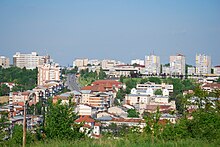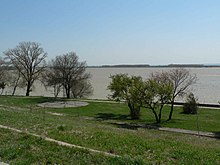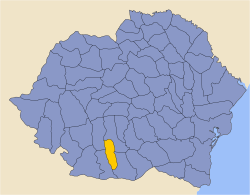|
Olt County
Olt County (Romanian pronunciation: [olt]) is a county (județ) of Romania on the border with Bulgaria, in the historical regions of Oltenia and Muntenia (the regions are separated by the Olt river). The capital city is Slatina. HistoryOn 24 August 2017, the Olt County Council decided to hold a name referendum on 15 October 2017 for the proposal to change the county name to "Olt-Romanați".[3] The referendum was eventually held on 6 and 7 October 2018.[4] The vote was nullified, as turnout was 27.19%, below the required threshold of 30%; therefore, the Olt County retains its current name.[5] DemographicsIn 2011, the county had a population of 415,530 and the population density was 75.57/km2 (195.7/sq mi).
The county is a mainly rural one, with over 60% of the population living in villages. GeographyThe county lies in a flat area on the western part of the Romanian Plain. It is crossed by rivers from north to south, including the Olt River which gave the county its name. The Danube forms a wide valley in the south, with many ponds and small channels, which are occasionally flooded. Neighbours
EconomyThe predominant industries in the county are:
Agriculture is the main occupation in the county - over 58% of the population having agriculture as their main occupation. Both extensive agriculture, and small-scale, vegetables and fruits, are practiced. The area is well suited for irrigation. TourismThe main destinations for tourists are:
PoliticsThe Olt County Council, renewed at the 2020 local elections, consists of 32 counsellors, with the following party composition:[8]
Administrative divisions    Olt County has 2 municipalities, 6 towns and 104 communes:
Historical county
Historically, the county was located in the southern part of Greater Romania, in the western part of the historical region of Muntenia, around and in the south of Bucharest. The county included the north-eastern part of the current Olt county, the south-western part of the present Argeș County and the north-western part of the present Teleorman County. During the interwar years, it was bordered to the north by Argeș County, to the east by the counties of Argeş and Teleorman, to the south by Teleorman County, and in the west by the counties of Romanați and Vâlcea. Administration The county originally was divided into three administrative districts (plăși):[9]
Subsequently, the county established an additional district:
PopulationAccording to the 1930 census data, the county population was 183,595 inhabitants, ethnically divided as follows: 98.2% Romanians, 1.2% Romanies, as well as other minorities. From the religious point of view, the population was 99.5% Eastern Orthodox, 0.2% Roman Catholic, 0.1% Jewish, as well as other minorities. Urban populationIn 1930, the county's urban population was 11,243 inhabitants, comprising 92.5% Romanians, 2.5% Hungarians, 1.5% Jews, 0.8% Germans, as well as other minorities. From the religious point of view, the urban population was composed of 94.1% Eastern Orthodox, 2.3% Roman Catholic, 1.6% Jewish, 0.9% Reformed, 0.6% Lutheran, as well as other minorities. ReferencesWikimedia Commons has media related to Olt County.
|
||||||||||||||||||||||||||||||||||||||||||||||||||||||||||||||||||||||||||||||||||||||||||||||||||||||||||||||||||||||||||||||||||||||||||||||||||||||||||||||||||||||






